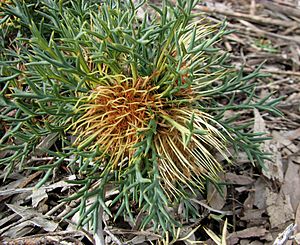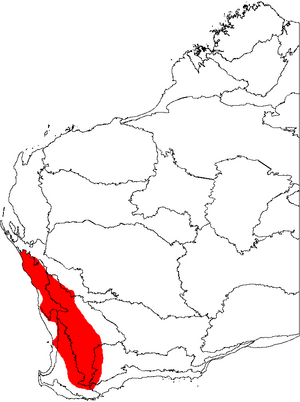Banksia fraseri facts for kids
Quick facts for kids Banksia fraseri |
|
|---|---|
 |
|
| Scientific classification | |
| Genus: |
Banksia
|
| Species: |
fraseri
|
Banksia fraseri is a type of shrub that grows only in Western Australia. It has stems covered in soft hairs and long, flat leaves with many sharp points along the sides. Its flowers are usually pink or cream-coloured, and they grow in groups of 80 to 100. After flowering, it produces woody seed pods called follicles.
Contents
Discover Banksia fraseri
Banksia fraseri can look very different depending on where it grows. Some plants are very low to the ground, almost flat. Others can grow into tall shrubs up to six metres (about 20 feet) high! When the stems are young, they are covered in rough hairs. But as the plant gets older, these hairs fall off.
Its leaves are usually 5 to 10 centimetres (2 to 4 inches) long and 8 to 40 millimetres (about 0.3 to 1.5 inches) wide. They have many narrow, pointed sections on each side, like a feather. Each leaf sits on a small stalk up to 3 centimetres (1.2 inches) long.
Flowers and Fruits
The flowers of Banksia fraseri grow in a special dome-shaped cluster. These clusters appear at the ends of branches or on short side shoots. Each cluster holds 80 to 100 individual flowers packed closely together. Small, pointed leaves called bracts surround the base of the flower cluster. The tips of these bracts are quite noticeable, which helps identify this plant.
Like all plants in the Proteaceae family, each flower has a tube-like part called a perianth. This perianth is made of four parts joined together, and it holds the pollen. There is also a long, thin part called a pistil. The pistil is first tucked inside the flower, but it breaks free when the flower opens. In Banksia fraseri, the perianth is 24–28 millimetres (about 1 inch) long and can be pink or cream. The pistil is longer, about 30–42 millimetres (1.2 to 1.6 inches), and is cream-coloured.
After the flowers bloom, they produce woody seed pods called follicles. These pods are firmly stuck into the woody base of the old flower head. Each pod usually contains two seeds with wings, which help them fly away in the wind. This plant is special because one flower head can produce many, many seed pods!
How Banksia fraseri Got Its Name
The first time scientists collected samples of Banksia fraseri was in 1827. A botanist named Charles Fraser found them during an expedition to explore the Swan River area in Western Australia.
Three years later, in 1830, another famous botanist, Robert Brown, officially described the species. He gave it the name Dryandra fraseri. For a long time, this plant was known as a Dryandra.
Changing Names Over Time
Over the years, different botanists studied and organized plants in different ways.
- In 1856, Carl Meissner kept Dryandra fraseri in a similar group.
- In 1870, George Bentham placed it in a new group called Dryandra ser. Armatae.
- In 1996, Alex George created a new group just for Dryandra fraseri, called Dryandra ser. Folliculosae. He named it this because of the unusually high number of seed pods (follicles) it produces. He also recognized five different types, or varieties, of Dryandra fraseri.
Then, in 2007, two scientists named Austin Mast and Kevin Thiele made a big change. They decided that all plants in the Dryandra group should actually be moved into the Banksia group. This meant that Dryandra fraseri officially became Banksia fraseri. This change helped simplify how these plants are named and understood.
Where Banksia fraseri Lives
Banksia fraseri grows across a wide area in Western Australia. You can find it from Kalbarri in the north, all the way down to Cranbrook in the south. It also grows quite far inland, near places like Kellerberrin. It likes to grow in shrublands, woodlands, and a type of open scrubland called kwongan.
Images for kids



